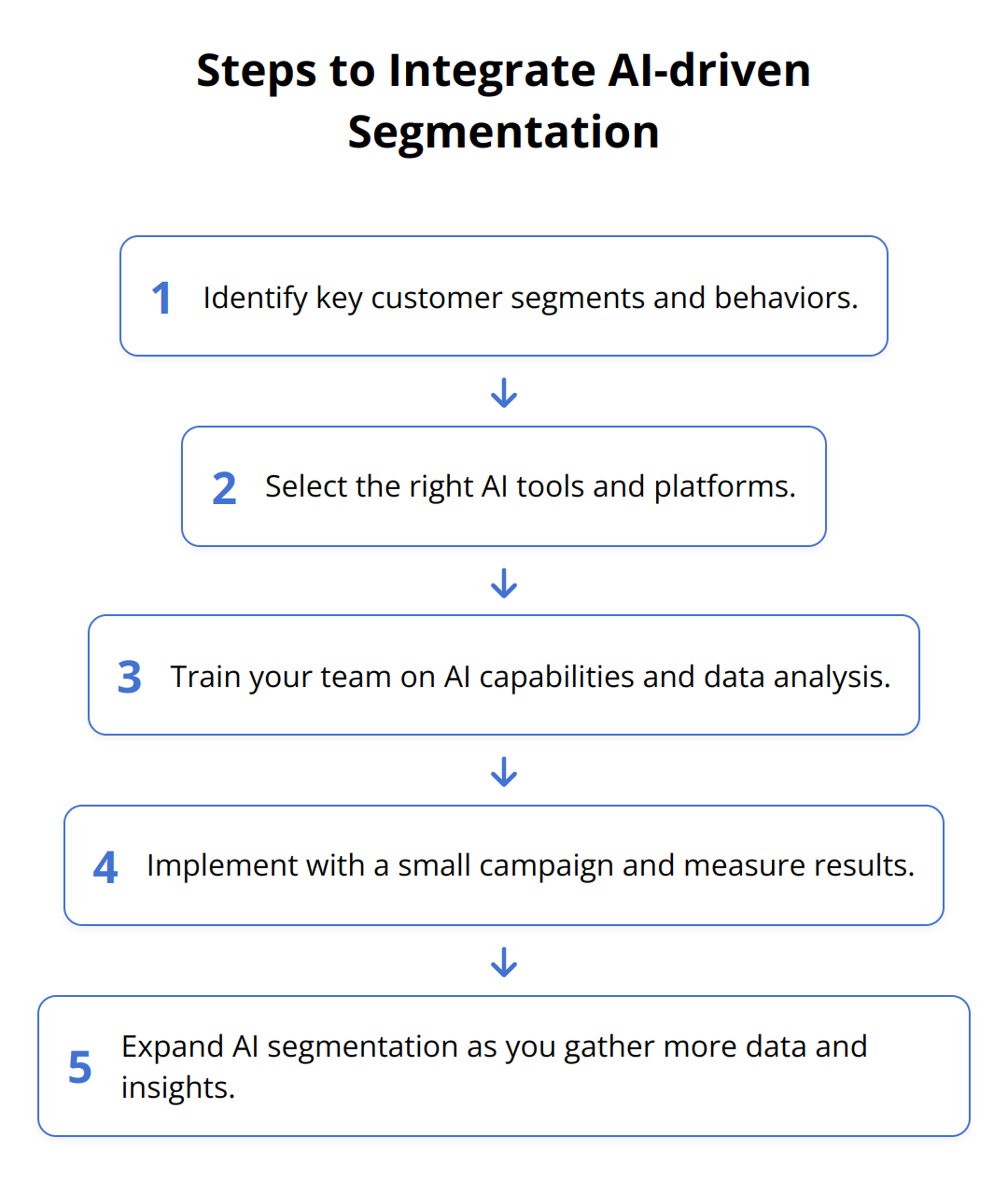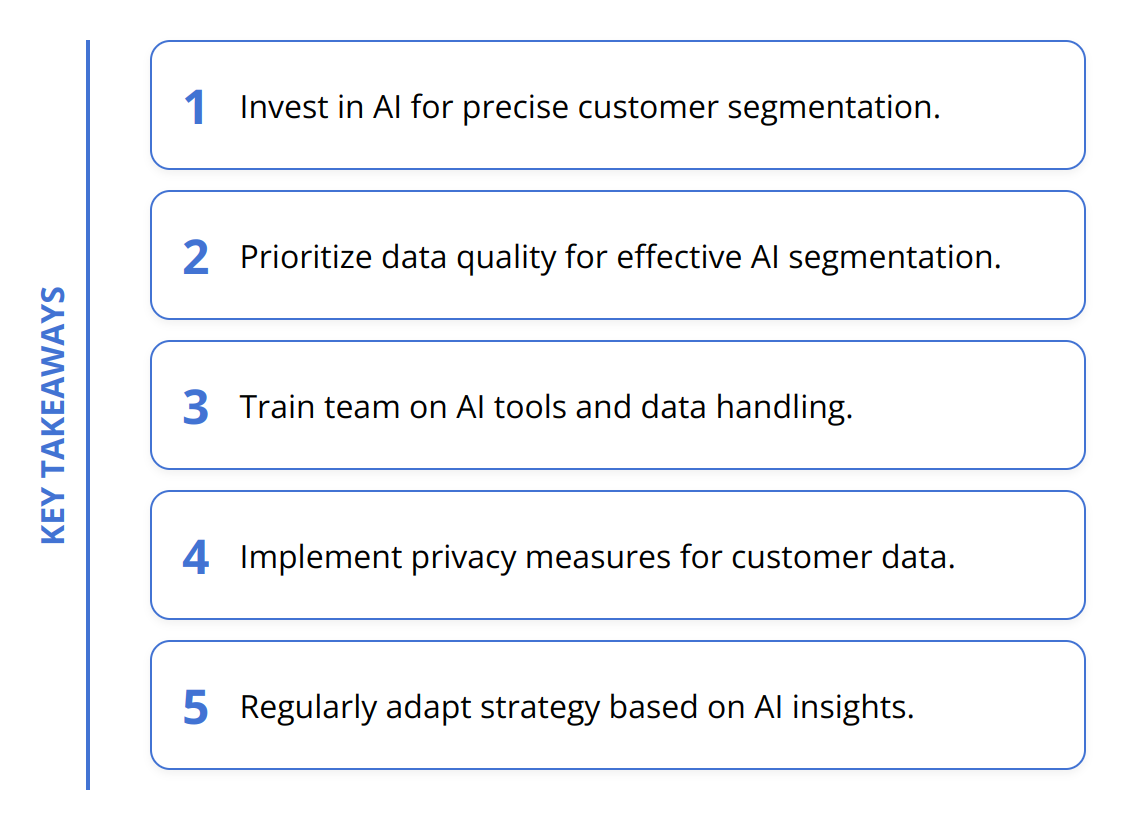Segmenting your customer base accurately is fundamental for any marketing strategy to succeed. Traditional methods often fall short in capturing the dynamic nature of consumer behavior. We at Emplibot believe that AI-powered approaches transform the landscape of customer segmentation, making it more efficient and insightful. This blog post explores how AI is revolutionizing this essential marketing practice.
Contents
ToggleWhy Segment Your Customers?
Segmentation is the cornerstone of any targeted marketing approach. By dividing your customer base into specific groups based on various criteria like demographics, buying behavior, or needs, you can tailor your marketing efforts to resonate more deeply with each segment. This precision not only boosts engagement rates but also significantly enhances ROI from marketing campaigns. Traditional segmentation methods, relying heavily on manual analysis and broad categorization, often miss the subtle nuances that define modern consumer behavior. In contrast, AI-powered segmentation uncovers these intricacies, offering a far more dynamic and effective approach to understanding and engaging your customer base.
The shift to AI-powered segmentation represents a leap forward in how businesses approach their markets. Unlike traditional methods, which might categorize customers into broad, static groups, AI leverages complex algorithms to analyze vast amounts of data in real-time. This allows for the identification of emerging trends, subtle preferences, and even predictive behavior patterns that manual methods could never reveal. The result? A marketing strategy that not only speaks directly to the heart of each customer’s needs and wants but is also agile enough to evolve with those needs over time.

Key Benefits of Precision in Segmentation
-
Increased Efficiency: AI dramatically reduces the time and resources needed to perform deep market analysis.
-
Enhanced Personalization: With AI, businesses can deliver highly personalized messages and offers, significantly improving customer engagement and satisfaction.
-
Predictive Insights: AI’s predictive capabilities allow companies to anticipate customer needs, often before the customers themselves are aware of them.
-
Dynamic Adaptability: AI models continuously learn and adapt, ensuring that customer segmentation remains relevant as market conditions change.
-
Cost Reduction: By targeting more precisely, businesses can reduce wasted ad spend on poorly matched customer segments.
Practically speaking, transitioning to AI-driven customer segmentation is not without its challenges. It requires investment in technology and a shift in mindset from broad categorizations to a more nuanced understanding of customer behavior. However, the potential returns far outweigh these initial hurdles. Businesses that have adopted AI in their segmentation strategy report not just better conversion rates but also improved customer loyalty and a stronger competitive edge.
For those ready to make the leap, starting with a clear objective is key. Determine what you’re trying to achieve with segmentation — whether it’s increasing sales, improving customer retention, or entering new markets. Next, audit the data you currently collect about your customers and identify gaps that need filling. From there, partnering with the right technology provider can simplify the process of integrating AI into your marketing efforts.
One practical tip for businesses is to prioritize data quality and privacy. High-quality, privacy-compliant data is the lifeblood of effective AI segmentation. Without it, even the most sophisticated AI models can lead to inaccurate targeting and wasted resources. Additionally, regularly revisiting and refining your segmentation strategy as you collect more data and insights is essential for maintaining its effectiveness over time.
For deeper insights on creating effective segmentation strategies, consider exploring resources like our guide on predictive customer segmentation and how it can elevate your marketing game. These tools not only offer a roadmap for implementation but also showcase the transformative power of AI across various industry sectors.
In conclusion, embracing AI for customer segmentation is not merely about keeping up with technological trends. It’s about radically enhancing how you connect with your customers, offering them the personalized, relevant experiences they demand. By doing so, you’re not just selling better — you’re building lasting relationships that drive sustainable growth.
How AI Changes Segmentation
The advent of AI in customer segmentation has been nothing short of revolutionary. By implementing technologies that understand and predict customer behavior, businesses can now target their audience with unprecedented precision. This involves complex processes, but let’s break down how it fundamentally shifts the segmentation paradigm and why it’s a game-changer.
Machine learning, a subset of AI, is at the forefront of this revolution. It uses historical data to learn and make decisions without being explicitly programmed for each task. This means that businesses can now tap into deep insights about their customers’ past behavior, predict future actions, and tailor marketing strategies accordingly. The power of machine learning lies in its ability to process and analyze data at a scale and speed no human could achieve, uncovering patterns and trends that were previously invisible.
Predictive analytics takes this a step further by forecasting future customer needs and behavior. It can identify potential customer churn, predict purchasing trends, or even suggest the next best action for engaging individual customers. This proactive approach allows businesses to stay one step ahead, ensuring they can meet customer needs before they even arise.
Moreover, automation in segmentation is a crucial benefit AI brings to the table. Traditionally, segmentation has been a time-consuming process, requiring manual data analysis and categorization. AI changes the game by automating these tasks, significantly reducing the time and resources needed to segment your market effectively. This automation also includes ongoing adjustments to segmentation as new data becomes available, ensuring that marketing strategies remain relevant and effective over time.

Practical steps to integrate AI into your customer segmentation strategy include:
-
Investing in the right AI technology: Choosing tools that suit your business needs is essential.
-
Training your team: Ensure your team has the skills to leverage AI tools effectively.
-
Focusing on data quality: AI is only as good as the data it learns from. Ensuring your data is accurate and clean is paramount.
-
Respecting privacy: Use AI responsibly, ensuring customer data is handled with the utmost privacy and security.
For those looking to dive deeper into leveraging AI for customer segmentation, valuable resources like our exploration on personalized marketing with AI offer insights and practical advice.

In essence, AI doesn’t just change how we segment our customers; it transforms the very nature of our marketing strategies, making them more personalized, efficient, and predictive. As businesses adapt to this new landscape, the potential for growth and engagement is boundless.
AI Segmentation in Action
Harnessing the power of AI for customer segmentation can radically transform your marketing strategy, making it more efficient, personalized, and data-driven. This transformation is not just theoretical; numerous businesses across various industries have seen significant improvements in their marketing outcomes by integrating AI into their segmentation efforts. Here are practical insights into implementing AI-driven segmentation, including success stories, tools, and actionable tips to incorporate AI into your marketing playbook.
Netflix and Amazon are standout examples of companies leveraging AI for precise customer segmentation. Netflix uses AI to analyze viewing patterns, providing personalized recommendations that keep subscribers engaged. Amazon’s recommendation engine, powered by AI, analyzes purchase history, searched products, and items in the shopping cart to personalize user experiences. These strategies have proven incredibly effective, with notable increases in customer satisfaction and retention rates.

For businesses ready to embark on their AI segmentation journey, an array of tools and services are available to facilitate the transition. Platforms like Optimove and Heap Technologies offer sophisticated capabilities for customer data analysis and segmentation strategies that are easy to integrate with your current systems. These platforms analyze customer behavior in real-time, allowing for dynamic segmentation and highly targeted marketing campaigns.
Tips for Effective AI Integration
-
Start Small: Begin with a single customer segment or campaign. This approach allows you to measure the impact of AI-driven segmentation and make necessary adjustments before scaling up.
-
Emphasize Data Quality: AI is only as effective as the data it processes. Ensure your data collection methods are robust, and your datasets are clean and up-to-date.
-
Ensure Team Readiness: Invest in training for your team to understand and efficiently use AI tools. A team that is well-versed in AI capabilities is crucial for successful integration.
-
Keep Privacy Front and Center: As you harness more customer data, the importance of data privacy and security cannot be overstated. Implement stringent privacy measures and ensure compliance with regulations like GDPR.
-
Monitor and Adapt: AI-driven customer segmentation is not a set-it-and-forget-it solution. Regularly review the insights generated, and be prepared to adapt your strategy as customer behaviors and market conditions evolve.

Businesses looking to supercharge their marketing efforts should consider AI-driven customer segmentation as a necessity, not just an option. The ability to predict customer needs, personalize marketing messages, and dynamically adapt to changing behaviors presents a significant competitive advantage. By following practical tips and leveraging the right tools, integrating AI into your segmentation strategy can elevate your marketing to new heights.
For more insights on predictive analytics and AI in marketing, explore our guides on predictive customer segmentation and AI in digital advertising. These resources provide valuable information for businesses looking to enhance their marketing strategies with AI.
Wrapping Up
AI has undeniably transformed the way we understand and segment our customers. It moves us beyond the limitations of traditional segmentation methods, providing a depth of insights and precision that was previously unattainable. From predictive analytics to real-time data processing, AI technologies enable a highly personalized approach to marketing, allowing businesses to speak directly to the individual needs and preferences of their customers.

Looking ahead, the prospects for AI in marketing are vast and exciting. As AI technology evolves, we can anticipate even more sophisticated tools for segmentation, including advancements in natural language processing and emotional AI. These developments promise not only to enhance the accuracy of customer segmentation but also to offer new ways to connect with customers on a deeper level.
For businesses yet to adopt AI in their marketing strategies, now is the time to take action. The competitive advantage gained from improved segmentation can lead to higher engagement rates, increased customer loyalty, and ultimately, greater revenue growth. Embracing AI is not about replacing the human element in marketing but enriching it, providing a foundation for more meaningful interactions between brands and their customers.
At Emplibot, we’re committed to helping businesses thrive in this AI-driven marketing landscape. Our platform automates content creation, ensuring your website is filled with SEO-friendly articles that engage your target segments effectively. By leveraging our tools, your business can stay ahead of the curve, offering content that meets the dynamic needs of your audience.
In conclusion, AI for customer segmentation is more than a trend; it’s a fundamental shift in how we approach marketing in the digital age. By integrating AI into your marketing efforts, you open the door to unprecedented opportunities for growth and connection with your customers. The future of marketing is here, and AI is at its heart.










 Rated Excellent 4.5
Rated Excellent 4.5